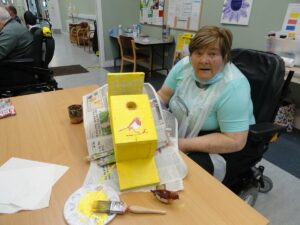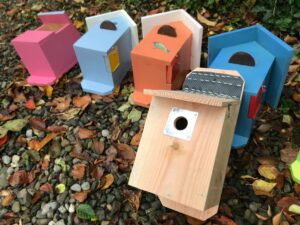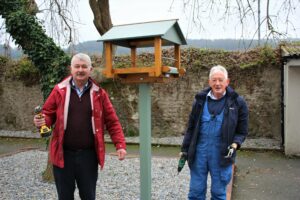An appreciation for the natural world around us can serve as a bridge between individuals, communities and even different generations.
Indeed, people of all ages gain great joy from seeing a curious Robin outside their window and, while the world we live in today is very different to that experienced by Yeats, humans today are equally as moved by the cry of the Curlew.
This universal curiosity in nature and the connections that it can forge underpins the Birds Connect project.
Supported by funding from Community Foundation Ireland, Birds Connect was a project rolled out by BirdWatch Ireland in 2021 with Andrew Lynch at the helm as Project Officer. Its primary aim was to connect people and biodiversity through citizen science, outreach and training. A key focus of the project was to explore and implement ways to improve access and participation in bird projects for people with disabilities, new communities and minority groups. Initiatives included outings to biodiversity hotspots, informative webinars and a very popular community nestbox scheme.
According to Fiona Dickinson of the Irish Wheelchair Association (IWA), the simple act of constructing and installing bird nestboxes through Birds Connect served as a foundation for something much greater for their members.
“I heard about Birds Connect on the radio and thought it sounded like a great idea. I then went and did a bit of research and emailed Andrew. He was so helpful and even sent out lovely fliers and posters of all the different birds,” explained Fiona, who works at The Dunraven Centre in Limerick – a Resource and Outreach Centre that provides day services to IWA members.
It all developed itself from there. Initially, it was intended to be a project for our Men’s Shed group because we are always looking for something for them to do. It can be hard to get them talking sometimes but if they are working on a project together, they will sit around and chat.”

Members of IWA Martin Carr and Tim O’Riordan working on their nestboxes. Photo: Fiona Dickinson.
Members of the Men’s Shed took on the task of creating ten nestboxes, while some of the other IWA members harnessed their creative flair and added unique designs to the finished boxes. Once the boxes were installed within the grounds of The Dunraven Centre, both a wealth of local biodiversity and a shared interest in it was unveiled.
“There was a lot of interest that I didn’t know they had. It was only by making the boxes and hearing everyone chatting that I realised the members knew quite a bit about birds,” said Fiona.
“It definitely helped them all to connect with each other more. From the window, they were able to identify different birds and have a chat about what they were seeing.”
While the IWA members later took the nestboxes home with them, the conversations and passion continued. Individuals would swap notes on the best locations to install the garden nestboxes, while their interest in birds also spurred them on to buy bird feeders for the centre garden. According to Fiona, the informational leaflets supplied through the Birds Connect Project are still proving valuable, as the IWA members use them to identify new visitors to the centre’s garden.
On reflecting on the survey and responding to a series of follow-up questions, IWA members said that they are now more aware of what birds come into their garden, adding that they have seen magpies, robins, pigeons, swallows, thrush, starlings, and crows. This group have since gone on to build a bug hotel and are very mindful of planting flowers that attract pollinators.
Rena Crofton showing off her vibrant new nestbox. Photo: Fiona Dickinson.
Terence Cassidy of the BirdWatch Ireland Meath branch has witnessed firsthand the benefits of community-focused biodiversity projects through his extensive involvement in Swift surveys, nestbox installation and guided walks across the county.
“It was knocking on doors during the initial Swift survey in 2016 that brought several people into the Meath branch who wouldn’t have thought of joining otherwise. They were interested and had a huge amount of knowledge but didn’t think anyone else would be interested. Getting involved in the Swift survey opened them up to a network of like-minded people who they otherwise may have not met,” he explained.
When Secretary with the Meath Branch Paul Gallagher brought the Birds Connect project to the attention of Terence, he was eager to get involved. They forged connections with Mosney Village and several local nursing homes and built and installed nestboxes for their respective residents to observe and enjoy.
“Mosney is a fantastic location with multiple habitats, being close to the sea, dunes and woodlands. It is a fabulous location in terms of increasing biodiversity and getting people engaged,” he explained.
“After doing a walk on the grounds, we decided to put in a Kestrel box as the dune habitat is ideal for Kestrels. We put a Starling box right beside the gate lodge. Meanwhile, we put Robin boxes by the gate where the kids would be picked up to go to school to support birds that wouldn’t be put off by people being around.”
Some of the many nestboxes made through Birds Connect. Photo: Andrew Lynch.
While the pandemic made it difficult for the BWI Ireland Meath branch to physically revisit Mosney or some of the nursing homes they installed boxes in, they are hoping to drive their efforts forward in the near future.
“We’d like to find ways to continue that conversation,” said Terence.
The Birds Connect project has led to many other initiatives for the BWI Meath Branch, as Terence explained.
“Birds Connect helped us to progress as a branch. We struggled to make small boxes at the start and then once we successfully made some of them, we went on and did a Kestrel box,” he said.
I wasn’t a bird box builder at all initially but through that work and the Swift work, I have become part of the bird box building team.”
As their confidence and skills grew, the branch moved on to constructing Barn Owl boxes. This has helped them to forge many new relationships, particularly with those in the farming community.
“I’ve met many farmers in the area who don’t use rodenticide and were keen for us to install Barn Owl boxes on their farms. We were very happy to do so. A lot of these farmers are very keen to do as much as they can to protect the environment,” said Terence.
2023 saw the completion of the inaugural Meath Barn Owl Survey – a collaboration between Birdwatch Ireland, the BirdWatch Ireland Meath Branch and Meath County Council that was funded by the Heritage Council and Meath County Council. The information gathered through this survey can now help us to better determine the most suitable sites for such boxes.
In all, Terence said that Birds Connect was a positive project for the branch to be involved in, one that pushed them to drive ahead with new initiatives.
“Birds Connect was a catalyst in terms of moving us into more hands-on conservation work rather than just awareness-raising talks and walks.”
Carrick-on-Suir Men’s Shed members, Pat Callanan and Tom Coleman, with their boxes. Photo: Brian White.
Through the Birds Connect project, Brian White of the Carrick-on-Suir and District Lions Club and his fellow members worked with the Carrick Men’s Shed to make bird nestboxes for installation in the locality. It was the club’s existing connections with local groups coupled with the fact that the environment is one of Lions Club International’s Five Pillars of Service that inspired them to get involved.
“I can’t remember where we came across Birds Connect initially but we could see we were very well-positioned to help out,” he explained.
I asked our Lions Club to support the initiative and got in touch with Andrew. He sent me details and links to bird nestbox designs and the posters and ID guides.”
The Lions Club teamed up with Carrick Men’s Shed – a group Brian described as “the heroes of the town”. The Men’s Shed members constructed high-quality bird nestboxes suitable for a variety of species, along with bird tables. After installing several of these and getting some local publicity for doing so, the Lions Club were contacted by other local services and individuals interested in getting involved. In all, they installed boxes and tables in three nursing homes, a daycare centre and a direct provision centre. They continue to provide birdseed to each of these five venues every winter.
“We are all extremely conscious of the decline in biodiversity and we are also conscious that we all have a role to play in supporting it. We can support biodiversity in our garden by providing food and nesting sites for birds, for example,” said Brian. “There is a greater awareness in the environment and an interest in getting involved.”




